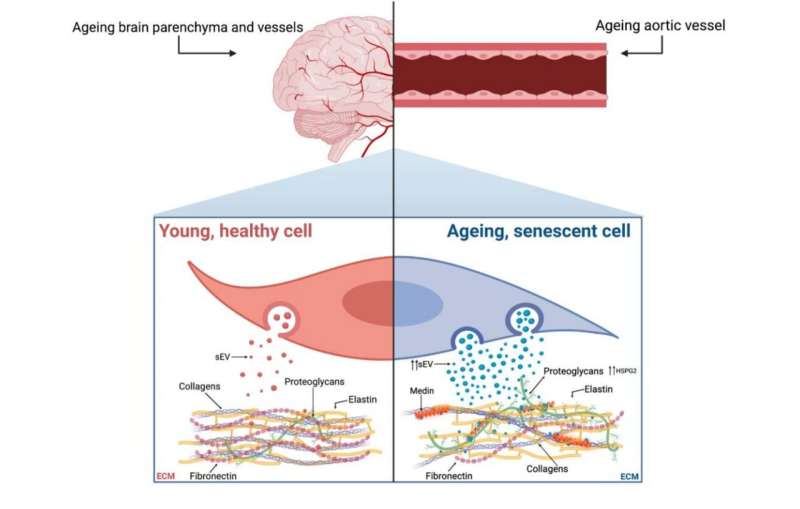This article has been reviewed according to Science X's editorial process and policies. Editors have highlighted the following attributes while ensuring the content's credibility:
fact-checked
proofread
Senescence and extracellular vesicles: Novel partners in vascular amyloidosis

A new editorial paper titled "Senescence and extracellular vesicles: novel partners in vascular amyloidosis" has been published in Aging.
In their editorial, researchers Meredith Whitehead, Marco Antonazzi and Catherine M. Shanahan from King's College London discussed amyloidosis—a prevalent age-associated pathology caused by the accumulation of fibrous, insoluble protein fibrils in tissues. The most common human amyloid is aortic medial amyloid (AMA), caused by aggregation of a 50-amino acid peptide called medin, which is cleaved by an unknown mechanism from its parent protein, milkfat globulin EGF-factor 8 (MFGE8). Medin is present in the vessel wall of 97% of Caucasians aged over 50 years, yet despite its prevalence in the aging population there is a very limited understanding of the mechanisms driving AMA.
The researchers explain, "Despite several forms of amyloidosis, including AMA and Alzheimer's disease (AD), being frequently associated with aging, there has been limited research to date on the effect of cellular 'aging,' termed senescence, on amyloidosis."
The novel data presented in the paper by Whitehead et al. provides evidence that vascular smooth muscle cell (VSMC)-derived small extracellular vesicles (sEVs) are key mediators of medin accumulation in the vessel wall. In addition, the authors identify, for the first time, a role for cellular senescence in triggering amyloidosis via changes in sEVs and extracellular matrix (ECM) composition. Thus, this study not only advances our understanding of how AMA is formed but uncovers potential therapeutic targets for mitigating the detrimental effects of amyloidosis on tissue function.
"Further work is now required to understand the relationships between cellular aging pathways, different forms of amyloidosis and potentially other aging pathologies with shared mechanisms, such as vascular calcification, that often occur concomitantly within the aged ECM," the researchers conclude.
More information: Meredith Whitehead et al, Senescence and extracellular vesicles: novel partners in vascular amyloidosis, Aging (2023). DOI: 10.18632/aging.204571



















